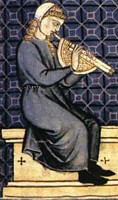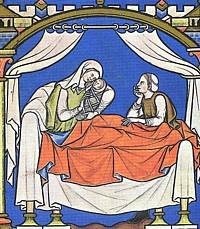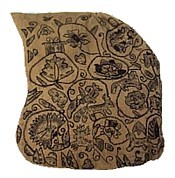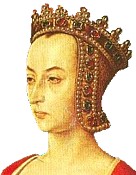|

dress
accessories
headwear
coifs
crowns, coronets
& circlets
hats & hennins
headdresses
veils
& wimples
hoods
|

Medieval
Coifs for Women
STYLES
- ST BIRGITTA'S CAP - MATERIALS
 Throughout
the medieval period, the coif remained one of the few items of
headwear which remained unchanged by virtue of its simple design.
It is best described as a close-fitting linen bonnet or cap, usually
tied under the chin. Throughout
the medieval period, the coif remained one of the few items of
headwear which remained unchanged by virtue of its simple design.
It is best described as a close-fitting linen bonnet or cap, usually
tied under the chin.
Many artworks show men wearong coifs and indeed, coifs are generally
associated with male clothing. There are some examples of coifs
or coif-like hair coverings for women.
It was constantly used as a hair covering in bed, or under hats
by the working classes and was the commonest daytime headwear
base worn by all classes of the community throughout Europe during
the 13th century.
Often the coif was used as
a base for a further head covering like a veil.

 Styles Styles
Many early medieval illuminations show women wearing white coifs,
or some variant, to hold their hair in place.
Shown at right is a detail from the musical manuscript, the Cantiga
St Maria from the 12th century where the woman musician wears
a coif similar to the male one of the time.
Long after they were abandoned by women, men continued to wear
the coif under other types of hat. Coifs were generally replaced
by hairnets, wimples and veils in the case of women.
St Birgitta's Coif or Cap
Another kind of coif, what we today call the St Birgitta's cap,
was widely worn in the 13th century. These coifs had more of a
bag at the back to contain the woman's hair, and the strings which
tie up under the chin, were extended and wrapped around the head
to hold the coif in place. It can be seen on the woman at the
left in the Morgan Bible image at the left.

 Materials Materials
Coifs for everyday wear were made of linen, the only difference
between those worn by the upper and lower classes was the material
from which they were made.
 As
hair covers worn in conjunction with other headdresses, materials
might also include silk or finer linens. As
hair covers worn in conjunction with other headdresses, materials
might also include silk or finer linens.
Shown here is an existing coif covered in blackwork embroidery
dated to the 16th century in England. Clearly, it is a coif designed
to be seen and not hidden under layers of other headdresses.
The detail at right from 1498 to 1499 of Anne De Bourbon shows
an elaborate jeweled coif worn underneath a heavily-jeweled crown.
This type of coif was not commonly worn, although some of the
more fabulous headdresses of the 14th and 15th centuries may have
had plain coifs as a base underneath them.

Copyright
© Rosalie Gilbert
All text & photographs within this site are the property of
Rosalie Gilbert unless stated.
Art & artifact images remain the property of the owner.
Images and text may not be copied and used without permission.
|